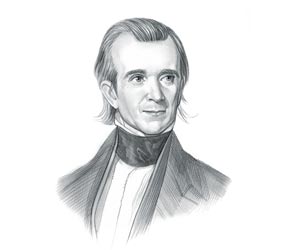|
The country expanded with the 1848
Treaty of Guadalupe Hidalgo when Mexico sold Alta
California and New Mexico to the US for $15 million.
The major accomplishments and the
famous, main events that occurred during the time that
James K Polk was president included the Indian Wars, the
Mormon migration to Utah (1846), Bear Flag Revolt
(1846), Wilmot Proviso of 1846, the Walker Tariff (1846) and the California gold
rush (1848). James Knox Polk
died of cholera on June 15, 1849, aged 53. The next president was
Zachary
Taylor.
Birthday:
November 24, 1784
Place of Birth:
Tennessee
Political Party:
Democratic
Nickname:
Napoleon of the Stump
Number: 11th
President
Vice President:
George M. Dallas
Age at Inauguration:
49
Height: 5 feet
8 inches
Weight: 174
pounds
First Lady:
Sarah Polk
Religion:
Presbyterian
Date of Death:
June 15, 1849
Date of James K
Polk
Presidency:
March 4, 1845 to March 4, 1849
The Nickname of James K Polk: Napoleon of the Stump
The nickname of President James K Polk provides an insight into how
the man was viewed by the American public during his presidency. The
meaning of the unsual nickname "Napoleon of the Stump" refers to
Polk's eagerness to exercise his considerable speech making skills.
He took every opportunity to deliver a speech, and tree stumps were
once utilized for this purpose, and his delivery was as fearsome as
Napoleon when he spoke..
Character and Personality Type of James K Polk
The character traits of President James K Polk can be described as
intelligent, persuasive, determined, forceful and ambitious. It has been speculated that the Myers-Briggs
personality type for James K Polk is an would be INTJ (introversion,
intuition, thinking, judgment). A reserved, analytical and
insightful character with a strong sense of independence. James K
Polk
Personality type: pragmatic, logical, individualist and creative.
Accomplishments of James K Polk and the Famous Events during his Presidency
The accomplishments of James K Polk and the most famous events during his
presidency are provided in
an interesting, short summary format
detailed below.
Westward Expansion
Summary of the Westward Expansion: The
Westward Expansion
encompassed the movement of Americans across the North American continent from the
Atlantic in the east to the Pacific in the west. The
movement west and the rapid settlement of territories was enabled by
buying land, victories in wars, treaties and the displacement of
Native American Indians. The process of Westward Expansion was made
possible by
progressive transportation systems such as roads, canals
and the railroads and the belief in the Manifest Destiny
of the United States of America.
Manifest Destiny
Summary of Manifest Destiny: The
Manifest Destiny
was the firm belief that occupation of North America was a
divine right of the American people.
The Mexican-American War
Summary of the Mexican-American War: The
Mexican-American War
lasted just under 2 years from and was fought between April
25, 1846 – February 2, 1848 in Texas, New Mexico and California.
California Republic and the Bear Flag Revolt
Summary of the California Republic and the Bear Flag Revolt: The
California Republic and the Bear Flag Revolt
involved conflicts between American settlers against Mexico in Alta California.
Wilmot Proviso of 1846
Summary of the Wilmot Proviso of 1846: The
Wilmot Proviso of 1846
was an amendment to an appropriations bill to gain funding
for the settlement of the Mexican-American War. The Wilmot Proviso
stated that slavery should be banned in the territories acquired
from Mexico, including California.
1848 Treaty of Guadalupe Hidalgo
Summary of the 1848 Treaty of Guadalupe Hidalgo: The
1848
Treaty of Guadalupe Hidalgo
was signed during the presidency of James K Polk when Mexico was forced to sell
Alta California and New Mexico to the US for $15 million.
California Gold Rush
Summary of the California Gold Rush: The
California Gold Rush
(1848–1855)
started started on January 24, 1848
at Sutter's Lumber Mill in Coloma, California during the presidency
of James K Polk. The
gold seekers, numbering over 90,000, were called the "49ers"
as the majority of them reached the goldfields in 1849.
Oregon Treaty 1846
Summary of the 1846 Oregon Treaty: The
Oregon Treaty 1846
settled
the land disputes between the US and Great Britain and
ended the twenty-eight years of joint occupancy of the Pacific
Northwest.
The Elias Howe Sewing Machine
Summary of the Elias Howe Sewing Machine: The invention of the
Elias Howe
Sewing Machine
revolutionized the shoe and clothing industry
providing the means for Americans to buy cheap, fashionable clothes.
|

